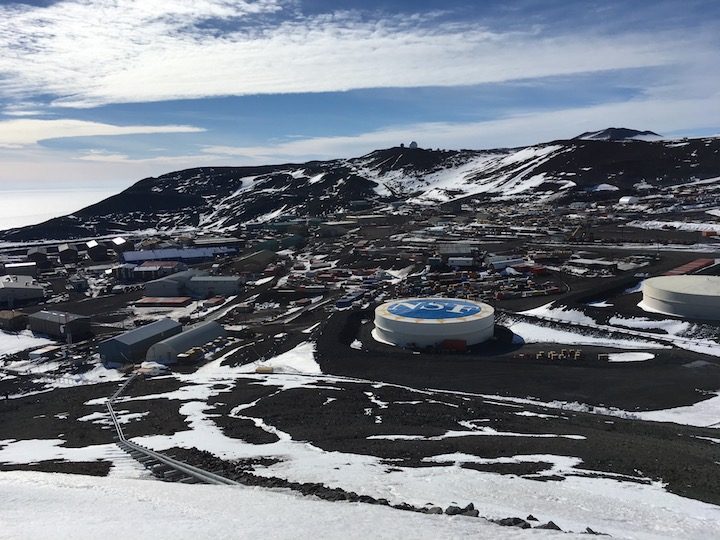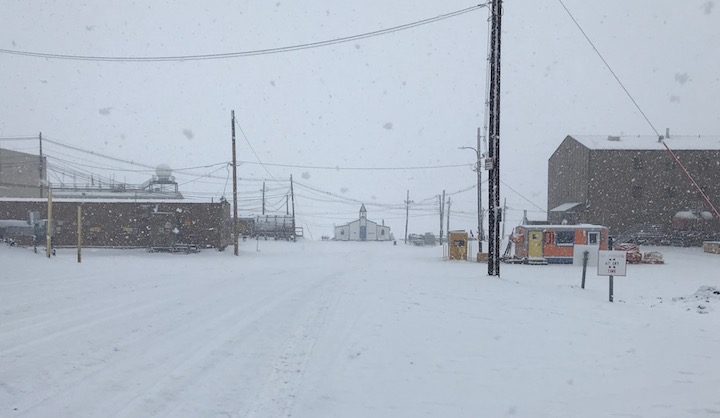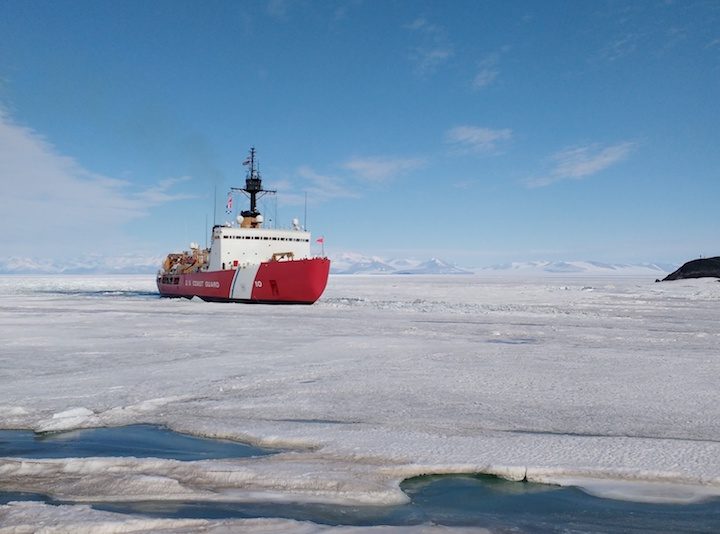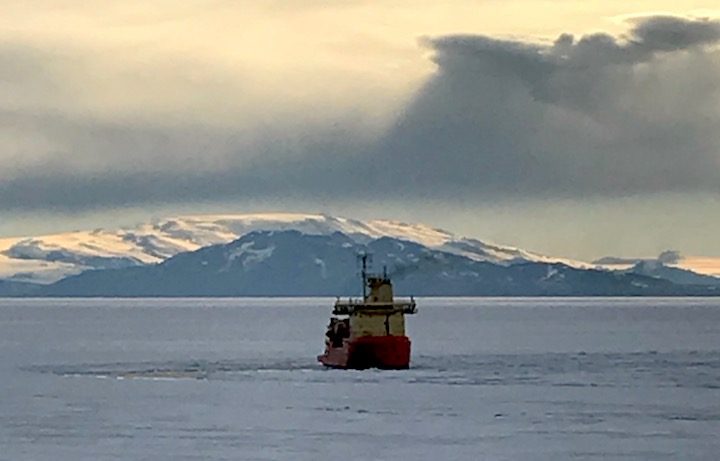

Tom and I have returned to McMurdo Station!
Our traverse is complete, our gear has been stored for next season, and we are ready to head north to warmer climates. But in the meantime, we are awaiting our flight to Christchurch, New Zealand, at Antarctica’s largest research station.

McMurdo Station from above (Photo: Tom Neumann)
McMurdo is one of three permanent US research stations in Antarctica. The other two are Amundsen-Scott South Pole Station and Palmer Station, which is south of South America. McMurdo has beds for approximately 1,000 people, but while we have been here, the population has hovered between about 750 and 825.
While there is a research station operated by New Zealand just 2 km away, McMurdo is relatively isolated. As such, there are facilities here that provide all of the basic essentials required for living in the polar regions, such as power, heat, and water. McMurdo has its own diesel-based power plant, providing lights and heat to the station. The station gets its fresh water through the desalinization of the sea water in the neighboring bay via a method called reverse osmosis. And McMurdo has its own waste-water treatment facility. To operate a station this size, and in this environment, McMurdo also requires an airfield, a galley, and all of the staffing that goes along with running a small town. It is quite an operation.

McMurdo on a snowy day, with the chapel in the background. (Photo: Kelly Brunt)
McMurdo station also has specialized facilities that support the cutting-edge science that happens here. These facilities include a sophisticated laboratory that is capable of housing a cross section of Antarctic research disciplines such as glaciology, geology, meteorology, and biology.
The research that takes place here also includes really cool meteorite science! The search for meteorites is a bit simpler here than in other parts of the world. Since Antarctica is a thick sheet of ice, rocks found on the top of the ice sheet are often associated with debris fallen from space; these meteorites stand out against the white surface. Plus, the flow of the ice organizes the meteorites, making them more centralized for collection. Some of our colleagues from NASA Goddard Space Flight Center are part of this effort.

The U.S. Coast Guard Cutter Polar Star, in McMurdo Sound. (Photo: Tom Neumann)
The pier in town is currently the busiest spot on station. The US Coast Guard Cutter Polar Star has cleared a channel into McMurdo Sound, giving three other vessels access to town. The first is the Nathaniel B. Palmer, the US Antarctic Program’s premier research vessel, which has been in town for the past few days. Simultaneously, the entire station is preparing for the arrival of the two other ships: the tanker Maersk Peary brings in the annual fuel supply, and the Ocean Giant cargo ship brings in the food and supplies for the following year.

The Nathaniel B. Palmer in McMurdo Sound (Photo: Kelly Brunt)
Tom and I are scheduled to leave McMurdo on the next flight. But the weather has deteriorated and we are left patiently waiting for it to clear. We are extremely happy with our successful field season and have had a fantastic trip. Thanks for reading and following along.
-Kelly & tom
By Alek Petty

Working on thin Arctic sea ice.
After five days of cruising through open water, it was clear we had to change course and venture further north to find ice. The satellite imagery was showing ice above 76-77 degrees North (we were around 74 degrees North), and the ice edge didn’t seem to be drifting south at any real speed. After another few days voyage northwards, we thus finally found ourselves entering the Arctic sea ice pack. This wasn’t exactly a scene from the Titanic; the transition from water to ice was a gradual one, as the ice cover evolved from millimeters or centimeters of newly forming sea ice (nilas and grease ice), to thicker, consolidated ice floes (maybe a meter or two thick; 3.3 to 6.6 feet), which caused the ship to lurch and shake as it broke its way through.

Early stages of sea ice growth: nilas (top left), pancake ice (top right), young grey-white ice (bottom left) and first-year ice (bottom right). The top photos are courtesy of Jean Mensa.
Once we were well within the ice pack, the Woods Hole team was keen to get out onto the ice and deploy some buoys. This would be my chance to get out on the ice too, as I was helping lead efforts to collect ice thickness measurements and ice cores, to better understand the characteristics (like salinity, density and age) of this year’s Beaufort Sea ice pack. The microbial and microplastic scientists were keen to join in and collect their own ice cores, too, enabling them to take a deeper look at what else might be hiding within the ice.
The Woods Hole team leader flew out with the helicopter pilot early the next morning to hunt for thick ice, and seemed to find an ice floe thick and stable enough for us to work on. I joined them on the first science flight out a few hours later to set out our survey lines and coring sites, before our cargo was carried over and the rest of the team members joined us. It was soon apparent that the ice wasn’t as thick as we had hoped.
I drilled a few quick holes and the readings all came in at around half a meter, just above what might be considered safe to work on. Our polar bear guard, Leo, wasn’t too happy with the conditions either and soon found a few good sized holes and cracks circling us. We were under strict orders not to stray from the group and to test the ice for stability as we moved ahead. I’ve previously used data from satellites, planes, and sophisticated computer simulations to estimate the thickness of Arctic sea ice. Yesterday, I estimated ice thickness by hitting it with a stick.

Danger ice!
It wasn’t quite vertical limit, and the group rebuffed my idea of roping together for dramatic effect, but there were still a few hairy moments when the odd leg found its way through the ice. Despite the added element of danger, all operations completed successfully and we hitched a lift back to the ship later that afternoon with our ice cores in tow. The Woods Hole team was working until last light to get their buoys prepped and ready to drift off through the Arctic. It was a fun, adrenaline-filled day of science, but I’d prefer it if we could find some thicker ice to work on next time around.
By Alek Petty

My journey up to the ship went smoothly and I even had time to observe the Northern Lights (Aurora Borealis) in full bloom during our overnight layover in Yellowknife (in the Northwest Territories of Canada). The following day, a Canadian Coast Guard helicopter transferred us from Kugluktuk airport onto the ship, and after another day spent refueling and replenishing the boat, we were finally on our way to the Arctic Ocean.

The Northern Lights.

The Louis S. St. Laurent ice breaker.
I actually spent the first two days of our polar expedition sat out on deck, enjoying the sunshine and views over the Amundsen Gulf. In the distance I could just about make out the mouth of the Mackenzie River delta – a key outflow of fresh and mineral rich river runoff into the Arctic. This shelf sea region is rich in wildlife, including beluga whales and even narwhals. We looked out eagerly, but only spotted a couple of lowly seals in the distance. Maybe on our way back we’ll have more joy.
On Saturday morning, we emerged into the Arctic Ocean proper —the Beaufort Sea! — where conditions were a bit less serene. In fact, one of the consequences of the diminished Arctic sea ice cover over the past decades has been an increase in Arctic Ocean waviness, as the lack of sea ice enables winds to more effectively whip up the ocean. Arguably one of the most distressing impacts of climate change for us unhardened scientists.
Despite the continued lack of sea ice, the water sampling exercises have begun in earnest. At each research station (a virtual station if you will, we just stop at a predetermined location in the ocean) a large metal carousel with various water samplers attached —a rosette, as we call it— is released, profiling the water column as it sinks to the bottom of the ocean, before being hauled back up to the ship for analysis.

A rosette deployment.
There are around 50 stations in total that we plan on hitting during this expedition. The various scientists on board all have their own things their looking for in the water —plankton, bacteria, alkalinity, dissolved inorganic/organic carbon, micro-plastics (yep, they make it to the Arctic Ocean too), etc. You name it, we’re sampling it.
One of my tasks, along with Japanese scientist Seita Hoshino, is to profile the water column in-between theses stations using XCTD (eXpendable Conductivity Temperature and Density) probes. XCTDs provide a quick and cheap (well, about $800 per probe, so not that cheap) real-time analysis of the temperature and salinity of the water column while the ship is moving. I’ll try and show you an example profile in a later blog post.
We’re hoping to hit some ice soon, as for us ice observers there’s not a whole lot for us to get really excited about yet. It’s quite the contrast to the cold, icy conditions of my 2014 expedition thus far…
By Walt Meier

A sign at the the Inupiat Heritage Center in Barrow, AK.
Jun. 1, 2016 — We started our last day of the camp with a morning visit to the Inupiat Heritage Center to learn more about the indigenous local culture. Many of the Inupiat in Barrow still live their traditional subsistence lifestyle – hunting, trapping, and fishing for food. They do however take advantage of modern technology to make their way of life a bit easier and safer. For example, now machines have replaced dogsleds and rifles have replaced harpoons. But for some things, the old ways did not need to be modernized: the sealskin umiaq kayaks are lighter (easier to carry across the ice) and more navigable in the narrow leads of open water common to the area than anything manufactured today. And the fur-lined coats, pants, and boots are lighter, warmer, and repel moisture better than any modern outdoor gear.

A painting of whale hunting at the Inupiat Heritage Center.
The Inupiat way of life is governed by the seasons. There is a season for whale hunting, for seal hunting, for polar bear hunting. The dark, cold winter season is a time to stay indoors and sew new clothes or repair old clothes. Festivals mark the seasons where the community comes together to celebrate and reinforce the bonds between families.
After visiting the heritage center, we headed back to our base for a final meal. Several times during the week, our field leader, Don Perovich, said that the key for a successful field expedition is “to eat as much as you can as often as you can.” And we were certainly well fed throughout, with plentiful sandwiches, instant soups, chips and crackers, and all-important chocolate for our typical mid-day meals. But our final meal in Barrow was a step above, thanks to Elizabeth Hunke at Los Alamos National Laboratory. She proved herself not only a top-notch sea ice modeler but also a great chef, putting together a delicious meal of spaghetti, garlic bread, and salad.

Last meal in Barrow.
Then it was time for our final sessions, presenting the data we collected and discussing our Grand Challenge efforts. Unfortunately, the data collection the previous day did not go as smoothly as we had hoped. We couldn’t collect albedo measurements because the instrument didn’t work yesterday. But this type of things is not at all unusual in field work. As Don said: “In Arctic field research, it’s important to make a plan; it’s also important to not become too enamored of that plan” because something inevitably will go awry and you have be prepared to adapt.
So we couldn’t directly compare one of the key surface features between the two sites. However, we had other data we could look at. The new site to the north was 10-20 centimeters (4-8 inches) thicker than the original southern site. So there was less melt there and the ice was likely to last longer there. And while we lacked some data, we had models we could use. Many people think of modeling simply as predicting the future – and indeed models are used for that purpose (e.g., weather forecasts), but models, particularly climate ones, are also used to investigate processes and learn how climate responds to different parameters. Though we didn’t have albedo data, we could adjust albedo in the model and see how that affected how the modeled sea ice evolves in the future.

Grand Challenge results.
Several folks worked late into the previous night to process data and run the sea ice model. We obtained climatological weather data, input the data into the model and run it for the first two weeks in June. The results showed that the melt was strongly affected by the albedo of the surface and the amount of incoming sunlight, and that there will likely be substantial differences between the two sites. In a sense this isn’t terribly surprising, but to see such variation over such a small distance (the two sites were separated by only a couple miles) and within such short time periods (two weeks) is sobering. Large-scale complex models and satellite data cannot (yet) resolve such variability. There is still much research to do, and those of us at the camp have come away a greater appreciation for the challenge.
We finished up by discussing future plans. The goal of this camp wasn’t simply to get everyone together for one week, but to start new collaborations between modelers, satellite folks, and field researchers. We discussed several ideas to build upon the start we’ve made, keep momentum going, and convey what we learned to the broader sea ice research community. With that, it was time to head to the airport and begin our long journeys home.
Another tradition Don has is to bring a lollipop to each field expedition. When the expedition is done, he pulls it out as a reward for a job well done. At the beginning of our camp, he gave each of us a lollipop. It was up to us to decide when we were done. Some pulled theirs out after we wrapped up the meeting; some enjoyed theirs at the airport. I waited until the plane left the ground.
And so my adventure on the ice has come to an end. I can’t say I’m an expert in the field or ever will be. But it has been a rewarding week for me. I’ve gained a lot of knowledge about what it takes to do field work. I’ve gained an even greater appreciation of the value of field observations, as well as modeling studies. Hopefully I was able to give participants a greater understanding of satellite data. And finally, now when someone asks me if I’ve been on the sea ice, I can say “Indeed I have!” I still have the taste of the lollipop in my mouth to prove it.

Until the next time, Walt.
By Walt Meier

May 29, 2016 — This morning, we had our second modeling exercise, led by Ian Eisenman of the University of California, San Diego, where we investigated whether sea ice loss is irreversible – i.e., is there a tipping point for sea ice, a point of no return? In the simple models, like the one we used yesterday, once the sea ice disappears under warming temperatures, the ice does not come back even if temperatures cool back down to where they started. This means the loss is irreversible. However, the ice loss is reversible in more sophistical models such as those used for most future climate projections. So are the simple models missing something essential, or do the more sophisticated models get it wrong?
We examined an in-between Goldilocks model –not too simple, not too complicated– and found that the simpler models do miss important processes, such as the fact that heat diffuses into larger regions. This spreads out and slows down the ice-albedo feedback so that if the temperatures cool, the sea ice will come back.
In the afternoon, my group did an optics exercise out on the ice. This primarily involved measuring albedo of the ice. Albedo is basically the proportion of sunshine that gets reflected by the surface. At its simplest, it can be thought of as the whiteness of the surface. A perfectly white surface reflects all of the sun’s energy and has an albedo of 1 and a perfectly black surface will absorb all of the sun’s energy and has an albedo of 0. Albedo is key for sea ice because the ice has a much higher albedo than the ocean. So as temperature rises, the ice decreases, the albedo drops and more energy is absorbed. This added energy warms things further and you get what is called the sea ice albedo feedback, which amplifies the effects of warming temperatures. But the ice doesn’t need to disappear to have the sea ice albedo feedback. Changes on the ice surface – such as melting and ponding – also reduce the albedo.

Measuring sea ice albedo.
Our goal for the day was to measure albedo along a 100-meter (328-feet) line across the ice. It was our first day here with substantial sunlight; we had blue skies interspersed with clouds. Unfortunately, this was a bad day for albedo: to get good measurements, consistent light is desired. So the intermittent clouds make things difficult. Don told us that normally, if he were in the field in such conditions, he would skip the albedo measurements and drill some thickness holes instead. But we went out and gave it our best effort.

In the evening, we had a visit from two native Inupiat whale hunters, Billy and Joe. They told us how hunting bowhead whales is a fundamental part of their culture. The hunters go out onto the ice to the edge of fast ice (ice attached to the coast) and wait for the whale to surface. When they catch a whale, they bring it up onto the ice and share it with the rest of the community. Sharing is part of the fabric of their society – though the hunters make the kills, they are supported by the entire community. At the end of the whale-hunting season in June, there is a big celebration throughout the town with food, music, and dancing.
Because they use the ice to hunt, the Inupiat have intimate knowledge of the ice cover. They have shared this knowledge with scientists; this provides a valuable complement to our scientific data because they see things that satellites, models, and even scientific field observations don’t. For example, they can sense the softness of the ice, indicating a weaker ice cover. They also provide a long record from their personal observations and oral histories passed down over generations. The hunters mentioned how the fast ice used to extend at least 4 miles from shore, but now it only about half that distance. The ice moves out earlier as well, which affects their seal hunting. Also, there used to be a lot of multiyear ice in the area, but now it is rare.
The Inupiat work with the scientists to better understand the changes in the sea ice and their changes on the community. The scientists also help Inupiat by providing data and scientific guidance. With the changing ice conditions, going out on the ice has become more dangerous for the Inupiat – ice floes can break off without warning, stranding hunters. They now can use the Barrow sea ice radar to see how the ice is moving to get a sense of when and where it is safe to go out onto the ice. It was really interesting to hear the perspective from the local community, an essential source of knowledge that provides a view of sea ice that we scientists don’t get in the field, in our models, or in our satellite data.